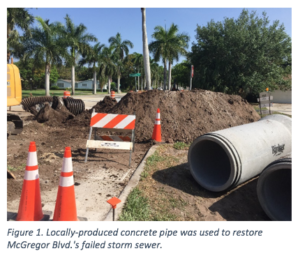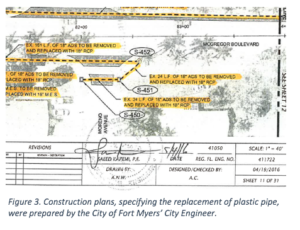Gateway to the City of Fort Myers is Restored with Concrete Pipe
By: Douglas J. Holdener, P.E., Florida Concrete Pipe Association

The recent restoration of a 2.2-mile section of historic McGregor Boulevard from Colonial Boulevard to Poinciana Avenue in the City of Fort Myers has been a long-awaiting solution. Most Fort Myers residents are familiar with the periodic lane closures and emergency construction over a span of a decade and a half. Most local civil engineers and civil contractors are familiar with the cause of the problems: a failing storm pipe system.
The McGregor Boulevard restoration project, officially known as McGregor Boulevard Flexible Pavement Restoration has been a true unification of a local community. Spanning nearly two decades after the initial drainage installation, McGregor Boulevard suffered from collapsing plastic storm pipes that resulted in pavement subsidence issues and warranted multiple open-cut pipe replacements.
 Through successful coordination with the Florida Department of Transportation (FDOT), the City of Fort Myers officials found a way to secure funding and restore the infrastructure, as well as the community. The city designed the project in-house, and the City Manager Saeed Kazemi, P.E. served as the Engineer of Record (EOR).[1] The $5.4M construction contract was awarded to Wright Construction Group, a local contractor. The concrete pipe was supplied by local producer Rinker Materials Concrete Pipe Division. Construction engineering inspection (CEI) services were performed by local engineer Paul Wingard, P.E. (KCCS Construction Services). Perhaps most importantly, the local media and the Fort Myers community were supportive of the project throughout the entire process.
Through successful coordination with the Florida Department of Transportation (FDOT), the City of Fort Myers officials found a way to secure funding and restore the infrastructure, as well as the community. The city designed the project in-house, and the City Manager Saeed Kazemi, P.E. served as the Engineer of Record (EOR).[1] The $5.4M construction contract was awarded to Wright Construction Group, a local contractor. The concrete pipe was supplied by local producer Rinker Materials Concrete Pipe Division. Construction engineering inspection (CEI) services were performed by local engineer Paul Wingard, P.E. (KCCS Construction Services). Perhaps most importantly, the local media and the Fort Myers community were supportive of the project throughout the entire process.
A History of Drainage System Problems
Public Works Director Richard Moulton considers McGregor Boulevard a “Gateway to the City.” In 2018, McGregor Boulevard turns 103 years old. Named after Ambrose and Tootie McGregor, the road’s construction was completed in 1915. Tootie McGregor Terry, whom remarried after Ambrose McGregor died in 1900, privately funded the construction of McGregor Boulevard in 1912 at the estimated modern-day-equivalent sum of $300M.[2] In addition, Tootie funded the annual maintenance for five years for a section of the roadway. [3]
 In 1923, McGregor Boulevard was designated as a state road. In 1999, the Florida Department of Transportation transferred ownership of the section of McGregor Boulevard located within the city limits to the City of Fort Myers. Subsequently, drainage pipe from Colonial Boulevard to Lynwood Avenue was replaced. [4] The pipe material used as part of the drainage construction was corrugated High-Density Polyethylene (HDPE) plastic pipe. Signs of apparent structural distress were recorded in post-installation inspection video records, dated recently after installation in 2000.[5] Over the next decade and a half, there were numerous repairs and pipe replacement projects to fix failing sections of the HDPE pipe installation and subsiding pavement.
In 1923, McGregor Boulevard was designated as a state road. In 1999, the Florida Department of Transportation transferred ownership of the section of McGregor Boulevard located within the city limits to the City of Fort Myers. Subsequently, drainage pipe from Colonial Boulevard to Lynwood Avenue was replaced. [4] The pipe material used as part of the drainage construction was corrugated High-Density Polyethylene (HDPE) plastic pipe. Signs of apparent structural distress were recorded in post-installation inspection video records, dated recently after installation in 2000.[5] Over the next decade and a half, there were numerous repairs and pipe replacement projects to fix failing sections of the HDPE pipe installation and subsiding pavement.
A Robust, Permanent Solution
The Fort Myers City Council and the City Manager, Mr. Saeed Kazemi, P.E. (Public Works Director and City Engineer at the time) engaged with FDOT and secured the programmed replacement of the pavement from Colonial Blvd. to Poinciana Ave. According to the current Public Works Director Richard Moulton, the timing to ultimately replace the entire plastic pipe system, rather than continue with the periodic replacements, was spurred by a series of super-tidal events that surcharged the drainage system in the coastal impacted zones. It is believed that the surcharge events exacerbated the compromised pipe sections leading to accelerated failures of the pipe embedment and more significant pavement subsidence. What would have been a more manageable fault became more cavernous concerns due to the surcharge events.
 The engineering plans directed the removal and disposal of 11,672 feet of storm sewer pipe. The failing pipe was replaced with 232 feet of Elliptical Reinforced Concrete Pipe (ERCP) and 11,440 feet of 18-inch through 30-inch Reinforced Concrete Pipe (RCP). In addition to replacing the plastic pipe, the project required the milling and resurfacing of 51,400 square yards of asphalt, the installation of 18,350 square yards of pavement base and subgrade material, 8,600 yards of asphalt, and 350 tons of asphalt leveling course.
The engineering plans directed the removal and disposal of 11,672 feet of storm sewer pipe. The failing pipe was replaced with 232 feet of Elliptical Reinforced Concrete Pipe (ERCP) and 11,440 feet of 18-inch through 30-inch Reinforced Concrete Pipe (RCP). In addition to replacing the plastic pipe, the project required the milling and resurfacing of 51,400 square yards of asphalt, the installation of 18,350 square yards of pavement base and subgrade material, 8,600 yards of asphalt, and 350 tons of asphalt leveling course.
 Mr. Moulton considers it a blessing that the natural super-tide events occurred in a manner that exposed the problems in the early daylight hours and that the City was prepared to ultimately replace the system with a robust, permanent solution. Mr. Moulton sees an appropriate fit for concrete pipe and plastic pipe within their work program. The City will continue to evaluate the use of appropriate piping materials consistent with is specifications and design parameters for right-of-way applications.
Mr. Moulton considers it a blessing that the natural super-tide events occurred in a manner that exposed the problems in the early daylight hours and that the City was prepared to ultimately replace the system with a robust, permanent solution. Mr. Moulton sees an appropriate fit for concrete pipe and plastic pipe within their work program. The City will continue to evaluate the use of appropriate piping materials consistent with is specifications and design parameters for right-of-way applications.
[1] McGregor Boulevard Flexible Pavement Restoration from Colonial Boulevard to Poinciana Avenue, Construction Plans, City Project #411722, State Project 437137-1-58-01, Prepared by City of Fort Myers for the Florida Department of Transportation, signed and sealed by Saeed Kazemi, P.E., May 4, 2016.
[2] Bickel, Mark, McGregor the boulevard, not the fighter, packs a punch in Fort Myers history, The News-Press, August 26, 2017, http://newspr.es/2wHIvxg.
[3] City Council and Board of County Commissioners Accept Mrs. Terry’s Proposition to Construct McGregor Boulevard, Fort Myers Daily Press, page 1, February 13, 1912.
[4] City asking for state help in funding McGregor Blvd work, on-line news article, Waterman Broadcasting Corp., NBC2, August 26, 2014, http://www.nbc-2.com/story/26378108/city-asking-for-state-help-in-funding-mcgregor-blvd-work.
[5] Video inspection records, prepared by Sewer Viewer, documented as for McGregor Boulevard, dated April 2000.

